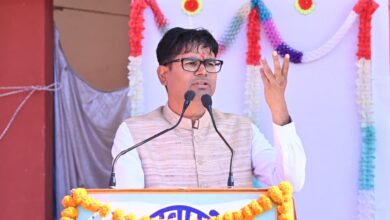DFCCIL MD Praveen Kumar Inaugurates Gati Shakti Multimodal Cargo Terminal at New Gothangam

New Delhi: the Dedicated Freight Corridor Corporation of India Ltd. (DFCCIL) marked a significant milestone with the inauguration of the newly constructed Gati Shakti Cargo Terminal (GCT) at New Gothangam (DGGN) on the Western Dedicated Freight Corridor (WDFC). Shri Praveen Kumar, Managing Director of DFCCIL, inaugurated the terminal in the presence of senior officials, including Shri SP Verma, GGM/Business Development, Shri Vikas Kumar, Chief General Manager/Mumbai North, Shri Praveen Tiwari AGM OP&BD, WDFC and other key stakeholders on 23rd March.
The development of GCTs is a pivotal initiative under the Gati Shakti Multi Modal Cargo Terminal (GCT) Policy, introduced by Indian Railways to revolutionize freight logistics infrastructure in India. The policy promotes collaboration between the public and private sectors to establish state-of-the-art cargo terminals with multimodal connectivity, ensuring seamless integration across rail, road, and port networks.
The newly inaugurated GCT at New Gothangam is the fourth terminal (3rd in FY 2024-25) to be operationalized under DFCCIL, following the successful commissioning of GCTs at New Rewari, New Bhaupur and New Daud Khan. These terminals significantly boost the freight handling capacity of the DFC network. DFCCIL has played a leading role in this initiative, having developed four out of the total seven GCTs commissioned under Schedule 2 (Railway Land) over Indian Railway.
Expanding Freight Infrastructure: Future GCT Developments.
To further promote terminal development, DFCCIL has issued an Expression of Interest (EOI) for setting up GCTs across 115 locations, aiming to transform all DFC stations into ‘Centres of Economic Activities’. Additionally, approvals have been secured for the establishment of terminals at New Sardhana station, reinforcing DFCCIL’s commitment to expanding India’s freight capacity. The GCTs in New Saradhna and New Sakun are already in construction phase and the approval for GCT in New Dabla is expected in March 2025.
Under the GCT Policy introduced by the Indian Railways, freight terminals are categorized into two primary schedules:
Schedule-2 (DFCCIL/Railway Land): Developed through an open tendering process, ensuring efficient logistics operations on railway-owned land.
Schedule-1 (Private Land): Developed and funded through private investments, enabling infrastructure growth through private sector participation.
The Schedule-1 terminals are being strategically developed at locations such as New Sanjali, New Rewari, New Malikpur, New Dadri, New Dabla, New Dharuhera, and New Jeonathpur. These terminals will accelerate the trade of commodities such as iron & steel, HR coils, fertilizers, marine gypsum, cement, food grains, automobiles, and containers, fostering regional economic growth and industrial expansion.
Strengthening India’s Supply Chain & Economic Growth GCTs are essential in enhancing India’s logistics efficiency, particularly in high-demand regions and strategic railway corridors. The initiative supports MSMEs by providing faster, cost-effective, and more reliable freight transport solutions. By facilitating better supply chain integration, these cargo terminals are expected to boost e-commerce, manufacturing, and export-import operations in the country.
DFCCIL is actively engaging with potential stakeholders through video conferences and in-person meetings to ensure the successful implementation of GCTs along Western and Eastern Dedicated Freight Corridors (WDFC & EDFC). So far, responses have been received for 51 locations, highlighting the strong interest and demand for modernized cargo handling infrastructure.
The inauguration of the New Gothangam GCT represents a significant step toward realizing the vision of the Gati Shakti initiative enhancing multimodal connectivity, streamlining logistics operations, and fostering economic growth. DFCCIL remains committed to expanding its freight network and strengthening India’s position as a global logistics hub.







